Forty miles east of Portland, Oregon, Bonneville Dam is the first big hydropower dam salmon and steelhead must cross when they return to the Columbia and Snake River. It doesn’t matter if they are heading for the Deschutes or Klickitat Rivers a few miles further upstream, or if they are going to go all the way to Idaho, they will swim through the viewing window at the Fish Passage Center and get counted. The counting has occurred since 1938, when construction at Bonneville was completed. Anglers across the region — and many from across the country — obsessively check those accumulating counts hoping for a sign that their favorite summer steelhead river, whichever beautiful Snake or Columbia tributary that might be, will have some fish to catch during the upcoming season. The run counts the last five years have been grim and the fishing has been slow. This year the numbers are an absolute nightmare.
Sometime around the end of July is usually the peak of the summer steelhead run at Bonneville. We’re weeks past that point now and the numbers are on track for what will probably end up being the worst steelhead run ever documented in the Columbia Basin.
For steelhead anglers, this year’s dismal fish returns are a gut punch, dreaded worst fears finally coming true. To make matters worse, the entire basin has been roasting under record-breaking heat waves all summer. Water temperatures at Bonneville Dam have exceeded 68 degrees for weeks on end and a few of the Lower Snake River Dams have been even hotter. Save Our Wild Salmon’s weekly Hot Water Report documents this miserable trend.
Oregon’s Deschutes River, one of the most famous and popular summer steelhead fisheries in North America, was hot enough that the Oregon Department of Fish and Wildlife (ODFW) put Hoot Owl fishing closures in place for several weeks to protect migrating steelhead and salmon and resident “redside” rainbow trout. Public pressure mounted for Portland General Electric (PGE) to cool the lower river with cold water from deep within Lake Billy Chinook, a sprawling, stagnant reservoir impounded by the Pelton-Round Butte Dam, the site of a controversial water draw tower that blends dirty, hot surface water with clean, cold water lower in the water column.
Like everyone else, Jeff Hickman was watching the temperatures climb and the fish counts falter.
Hickman has fished the Deschutes for thirty years, and has been guiding fly anglers out of jet boats on the lower river for fourteen. Usually, he and his guides start running day trips in July, as the first bright fish begin to arrive. They transition to running multi-day camps around the beginning of September, when the water temperatures are cooler all day, and run through to October, fishing every day of the season that jet boats are allowed on the river. Hickman’s operation has a stellar reputation and open spots are coveted. These trips book up far in advance, and many of their clients come every year from all over the country to fish. The Deschutes season is vital to the annual income of Fish The Swing, Hickman’s guide service and outfitting company.
This summer, Hickman and his guides quietly cancelled their July day trips because of brutal water temperatures. Hickman, a longtime River Steward for the Native Fish Society and an outspoken conservationist, knew the water temps could have meant accidentally killing wild steelhead they caught. Fish the Swing had long held a company policy never to fish when the water was above 68 degrees, even when, most years, ODFW refused to enact the same policy. He kept watching the grim fish counts and weather forecasts and listening for word from ODFW on guidance for how the fishing season might responsibly proceed in the face of such low steelhead returns.
In early August, ODFW closed the fabled North Umpqua River on Oregon’s coast. Warm water and low flows combined with dam counts and snorkel surveys revealed that wild steelhead returns were only 20% of the ten-year average—almost identical numbers to those being observed in the Columbia Basin. Then, a few days after the North Umpqua closure, ODFW announced that instead of reducing the season or adding further restrictions to protect the faltering number of wild steelhead returning to the Deschutes, they instead lifted Hoot Owl regulations despite water temperatures still remaining too high to safely fish in the afternoon.
It was too much. After weeks of losing sleep, and with no relief coming from daily checks of the Bonneville fish counts, Hickman talked to his team and made the decision to cancel their entire season. In a moment, the lion’s share of their annual income was vaporized.
In an email to his clients, a copy of which is now posted on Fish the Swing’s website, Hickman wrote: “Unfortunately, I'm writing here with some bad news. Because of the terrible run numbers, high water temperatures, and continued mismanagement by ODFW and PGE, we have decided to cancel our fall steelhead season on the Deschutes. I'm sorry to have to do this because I look forward to fishing with all of you each year, but I don't feel that conducting our regular business this year is ethical. The risk of killing even one wild steelhead is too many. The river has none to spare.”
The entire letter is worth reading.
Hickman is a well-known figure in the steelhead fly fishing community and industry. He’s a guide who is featured in ads, sponsored by major gear brands, and has been a Patagonia ambassador for quite awhile. He’s appeared in a number of steelhead fishing videos and countless magazine articles and blog posts over the years. He has helped design spey lines and a number of his fly patterns are commercially produced. His Fish Taco is a killer pattern for swinging on a sink-tip.
This is all to say: Hickman has a platform. When he posted on social media that Fish the Swing was cancelling their Deschutes season just as fishing normally would have been reaching its fever pitch, the announcement was met with a strange combination of accolades and silence. Conservationists and many anglers celebrated the move, but the majority of outfitters, shops, publications, and companies in the region, especially those focused on Columbia and Snake River summer steelhead, haven’t publicly acknowledged it. In conversations held behind-the-scenes, many are struggling with the same questions as Hickman, but others see his move as a publicity stunt and continue to fish the Deschutes like 2021 is any other, normal season. ODFW posted defensive comments responding to Hickman on social media, but otherwise hasn’t said anything or changed regulations in any meaningful way. (Editor’s note: Days after our interview, ODFW closed the lower Deschutes to steelhead angling for the month of September. See the update below for more information.)

Meanwhile, steelhead numbers at Bonneville continue trickling in at anemic, heartbreaking levels. The numbers at Lower Granite, the last of the Lower Snake River Dams steelhead cross to reach Idaho’s Clearwater and Salmon Rivers, are even worse.
Impressed by his leadership and sacrifice, we reached out to Hickman on the Oregon Coast, where he is working as a campground host and living with his family in a trailer. We wanted to make sure that his message wouldn’t get ignored and see what he thinks is required next. The conversation around steelhead conservation and angling is a tough one sometimes, for many reasons, but it was great to catch up with him. Our conversation has been edited for length and clarity.
Hatch Magazine: Hickman, cancelling your season is a huge decision to make, especially on such short notice. How did you and your team at Fish the Swing end up making such a tough call?
Hickman: Well, I would say that it’s been kind of a thought, really, for the last four years of low returns. Especially with my team, Barrett and I would be fishing and comparing notes and it has been like, “Man … where the hell are the fish?” We never really talked about what our threshold would or should be, but this year, when the fish just weren’t arriving, and you saw the graph keep getting further and further away from where the numbers should be, it just kind of came natural to say I really don’t think that it's ethical to go fishing this year.
I mean, I just had zero desire to be on the river. And the fact that the water temperatures have been so extreme this year just made the decision that much easier.
But the real basis was just the ridiculously low numbers. If you don’t draw the line this year, when do you? How low do the numbers really have to get for you to say enough is enough?
HM: Like the rest of us, I’m sure your clients were looking forward to steelhead fishing this year. How have they reacted to the decision?
Hickman: It's been incredibly positive … I haven’t heard a single negative comment from any of them yet.
You know, I’ve always gotten the sense that, as a guide, our customers really trust our judgement as a spokesman for the resource. They don’t just pay us to take them fishing, and move them from spot to spot, or give them casting tips. They are paying for our knowledge, judgement and experience. They trust us.
So, every single client that has reached out has been unbelievably understanding, and sympathetic to our financial situation. And really, they’ve just been stoked that we put our foot down and took a stand.

HM: You’re in this trusted role, and taking a stance that puts you out ahead of fishery management right now. Can you talk a bit about what it means to be put in this position and what you’re trying to do here?
Hickman: It is really frustrating because they are looking at the exact same numbers I’m looking at. And it just seems like our agencies are led by a bunch of cowards too afraid to stick their neck out. I don't know if everybody is afraid to say something and get fired, or if they're just too afraid to tell it like it is, because that will result in fewer license sales and less revenue for the agency.
It seems to me like there is a fundamental shift that needs to happen if these agencies are truly going to be going to bat for wild fish and not just angler rights.
I mean their whole budgets are tied to fishing license sales. That sure seems like a conflict of interest to me.
HM: So, at this point, we have the lowest run numbers anyone has ever seen. We’re in an emergency. What do you think are the next steps? One guy shutting down his camps and fishing trips calls attention to the truth of the situation, but what do we need to do next to really start changing direction for the fish?
Hickman: First, I just think that in this day and age, we just need to err on the side of caution. We can’t, you know, always be pushing the limits like, “Oh, this is our maximum allowable take under ESA guidelines.” That is fucking bullshit. You don't see the state of Alaska issuing hunting tags for the last 200 polar bears, you know what I mean? That’s what this is. These are an endangered species and you have these agencies that are too afraid to pass the most modest of protections for these fish.
"So, at a bare minimum right now we need to close every cold water refuge in the mainstem of the Columbia River: Every single one. Permanently. These are key locations the fish use to escape lethal water temps and they should be set aside as sanctuaries. They need to include the entire cold water plume out into the Columbia at the mouths of every tributary. Steelhead, and salmon, pack into these places to rest and recover every year. They need these refuges to survive their migration when the mainstem is too hot. It is unethical to fish there. We should be happy to fish in migration corridors when temps are safe and leave some critical places alone for their protection."
I mean … There is a long list.
We need to talk about big things, like dam removal, particularly the four Lower Snake River dams. We know those dams have outlived their lives and the negative impact they're having just doesn't pencil out.

But there are also really basic things we need to do.
In the ocean, we’ve been providing marine reserves to give fish protection to rebuild their populations. It is pretty popular and I think most people agree that it has been successful. We need to have the same concept in our rivers. The fish need critical refuge, whether it's temperature protection or just important places where the fish are known to congregate and hold where they are at risk of being really damaged by sport or commercial fishers. These are places like confluence pools, where we know the fish need to rest and recharge to survive and reproduce. We need to leave these fish alone in those special places.
It is just like hunting regulations. There are some critical areas the animals need and you’re not allowed to hunt in those places.
Beyond that, we obviously need to remove the gillnets in the Columbia River. We should be requiring selective commercial fishing and harvest methods, not using something like a gill net that is indiscriminate and kills everything.
And in the day and age of climate change, we need more active management. I think we need to have weekly assessments of each river and temps. Agencies should look at weather predictions and put out regulations week by week. If a heat wave is building, and you know water temps are going to be lethal in the afternoons, just close it completely that week to protect the fish.
Maybe each week could be one of three scenarios: Red light means closed. Yellow light means Hoot Owl. Green light means temps are good and you can fish all day.
Basically, it goes back to my point: If we are going to keep fishing for steelhead at all, we need to always err on the side of caution. That needs to be our starting point every time.
HM: It is a huge, complicated topic, but for readers and anglers who might not be familiar with the issue, can you walk us through the water temperature and pollution impacts you’re seeing on the Lower Deschutes in the last decade since the Selective Water Withdrawal tower started operating at the Pelton-Round Butte Dam on Lake Billy Chinook?
Hickman: What you have to know is that the lower Deschutes is a hundred mile long tailwater. When the dam was up for FERC relicensing, the utility (PGE) had to promise a bunch of money for upstream salmon and steelhead reintroduction efforts in order to get their license to keep operating another fifty years. Three different rivers — the Metolius, the Middle Deschutes, and the Crooked — all feed into Lake Billy Chinook and the dam and reservoir has really helped destroy the anadromous populations of fish in the upper Deschutes Basin.
The primary concept they came up with was to install this tower in the reservoir that allows PGE to blend water from different depths and help funnel migrating juvenile salmon steelhead downstream by creating an artificial current on the surface of Lake Billy Chinook. They get collected into a trap at the tower and moved safely around the dam.

The problem is, they need to use surface water to create current on Lake Billy Chinook because the reservoir is too still otherwise and the smolts can’t find the trap. That water is much warmer, at a different pH level, and filled with algae and nutrient pollution, and it ends up getting spilled downstream in their new blend of surface and bottom water.
This means the lower Deschutes is now warmer and much more polluted. They are trying to reintroduce sockeye salmon, summer steelhead, and Spring Chinook upstream, but they are making the lower river warmer and killing these same fish downstream long before they ever reach the dam. Not to mention ruining the habitat of native, wild redside rainbow trout.
At the same time, we’re seeing dramatic climate change — warming and drought — during the last eleven years. Our snowpack has just been dismal. It’s a perfect storm, but we need to reevaluate this relicensing agreement and figure out a way to cool the lower Deschutes down, which in turns helps cool the Columbia River down and creates an amazing cold water plume and refuge at the mouth. All the fish migrating upstream in the Columbia rest here, and many hang out in the Deschutes until the Snake River and mainstem Columbia cool off. We know that from telemetry studies.
I joke all the time that I catch more Idaho B-runs in the Deschutes each season than anyone on the Clearwater!
The idea of reintroducing fish to the upper basin is amazing, but we can’t keep doing it in a way that sacrifices the water quality of the lower river. I mean, PGE doesn’t care about the fish. They just want their license to run the dam, so we need to make them do better. The way they are doing it now doesn’t make any sense.
The Metolius is cold and clean. Reintroduce fish there. The Crooked River is drained by irrigation withdrawal and needs huge amounts of habitat restoration in the riparian zone. Because of all the agricultural runoff and lack of riparian protections, it adds a great deal of nutrient pollution to Lake Billy Chinook. Then the surface of Lake Billy Chinook cooks in the sun and gets hot and fills with algae, but they make smolts swim through that water to reach the tower and then spill that terrible surface water downstream.
They need to admit the tower has been a failure and they need to abandon the fish trapping program there. They should be gathering smolts at the mouths of the three tributaries when they migrate out in the spring and just drive them around Lake Billy Chinook instead. It is a dead zone for salmon and steelhead.
Obviously, the best option for the entire river basin would be to remove the dam, but PGE got their license renewal. They can flip a switch and draw more cold water from the bottom of the reservoir. We’ve seen it happen many times, including this summer. So, it just seems to me that we have to figure out a better way to do this because the dam isn’t going away anytime soon. The tower isn’t working and the lower Deschutes won’t survive another 35 years of this mess.
(Editor’s note: Check out the Deschutes River Alliance to learn more about the water quality issues impacting the Deschutes River because of the Pelton-Round Butte Dam and SSW Tower.)
HM: These are huge issues and it's incredibly important that you’re bringing attention to all of it, but what about the personal impacts of your decision not to fish? You and your team are going to lose an entire season’s worth of income. It is easy to admire the stance you're taking from where we sit, but what is your plan for what comes next?
Hickman: I’m very, very stressed, but you know what? I’m just going to have to do what I have to do. Maybe playtime is over. Maybe I’m going to need to go get a real job like everyone else.
I mean … I’m hugely in debt. We haven’t been able to run our lodges in Canada for two years because of the border closure and Covid. I’m making payments on jet boats that aren’t worth as much as the loans are for. I don’t have savings built up. My family is living in a trailer on the coast so we can rent out our house instead. My season on the Deschutes is a huge part of my income every year.
It is hugely scary. I poured my entire life into building this business, but I'm also in a very unique position as a steward, where I feel like my voice carries some weight and I need to speak up.
I’ve also been lucky. My clients are awesome and many of them have told us to keep their deposits to help us out. Some have bought gift certificates they have no intention of ever cashing. Some have offered to help us get other work for the winter. They’re proud of what we’re doing.
But that’s the thing … These fish are disappearing and we need to be doing more. We can’t just maintain the status quo and keep riding out a few more seasons trying to catch the last steelhead. We need to change directions and we need to do it now. Look at the numbers of fish crossing Bonneville: If not this year, when?
I always said I’d quit fishing if that’s what it took. And, you know, it's time. I still want my son to have a chance to catch a wild steelhead someday. We need to speak up - all of us - and make the agencies really make some tough decisions and take real actions or we are going to lose these fish.
Update
Days after our interview, the Oregon Department of Fish and Wildlife (ODFW) announced that steelhead fishing closures will begin on September 1 on the Deschutes, Umatilla, John Day, and Walla Walla Rivers. On the Deschutes, the closure will last a month and only applies to the lower river below Sherars Falls. As of now, anglers are able to continue fishing for steelhead above the Falls. In their press release, ODFW adds: "Managers will monitor the return and consider whether the fishery can reopen in October or whether further restrictions are needed." Guides and shops who had been continuing to to fish their regular have now lost the peak of their season and are reeling from loss of income or making plans to switch to trout and salmon fishing, both of which are still allowed on the lower river, or are moving above Sherars Falls to continue fishing for steelhead.
The rules are a small step in the right direction, but beg the questions: The Deschutes was dangerously hot during July and much of August. Why didn't ODFW close it then instead, when fish were being killed by high water temperatures? Why didn't it close above Sherars Falls, too? After all, the river hasn't reached its escapement goals in a decade. This year, with the terrible run numbers, it isn't like there are plenty of steelhead above the falls either.
In the meantime, as of our publication date, neither Washington or Idaho fishery managers have taken any emergency rule changes to provide additional cold water refugia or limit seasons on tributaries. This is frustrating because Washington manages a greater number of widely acknowledged cold water plumes in the mainstem of the lower Columbia and, as of now, Idaho has only seen 650 steelhead cross Lower Granite Dam. Even in the terrible runs of the last five years, they would normally be an average of 2500 above this threshold by now.
Links
Fish The Swing: http://www.fishtheswing.com
Native Fish Society action alert: https://nativefishsociety.org/action-alerts/columbia-steelhead
Fish Passage Center at Bonneville Dam: https://www.fpc.org/fpc_homepage.php
Lower Granite Dam Passage: https://idfg.idaho.gov/fish/steelhead/dam-counts
Deschutes River Alliance: https://deschutesriveralliance.org





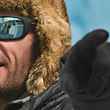


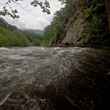



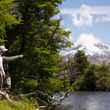


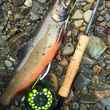
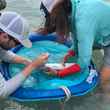



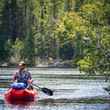



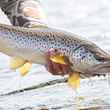
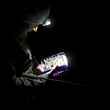



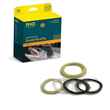

Comments
Thom Jaquysh replied on Permalink
Thank you for a great article and to Jeff for taking such a principled stand, even though it affects his family and the guides he works with.
Michael Schweit replied on Permalink
Here is a challenge to every steelhead angler out there. You were planning a trip and now it looks like it is cancelled or you are pulling the plug on your own DIY trip for all the reasons mentioned. Send your funds to those motels/hotels where you usually stay. Send your guide his regular fee. You can see where I am going with this but here is the thing. You were going to spend that money anyways so why not support those that will suffer the most.
Pages